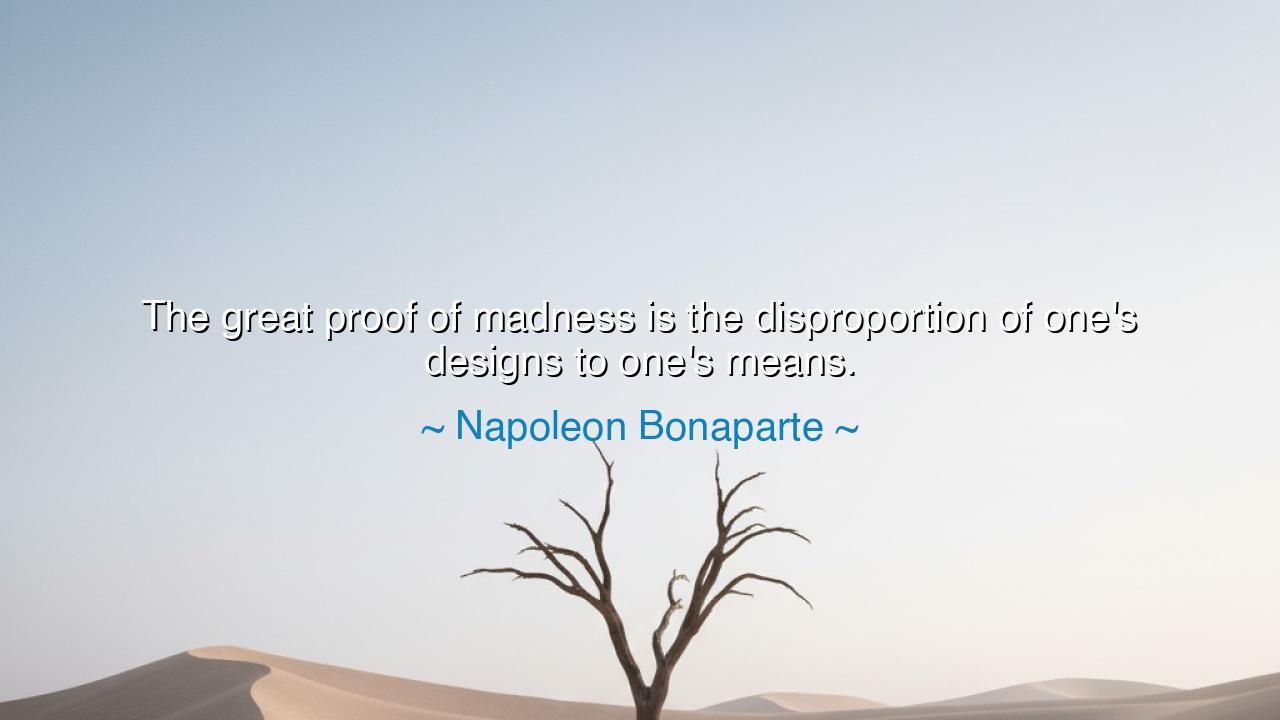
The great proof of madness is the disproportion of one's designs






“The great proof of madness is the disproportion of one’s designs to one’s means.” — Napoleon Bonaparte
From the lips of Napoleon Bonaparte, conqueror of nations and architect of empires, comes this piercing reflection—a truth as sharp as a blade drawn from the forge of experience. Few men in history have known both the heights of glory and the depths of downfall as he did. And so when he speaks of madness, it is not as a philosopher in abstraction, but as one who saw its shadow in his own soul and in the dreams of those who sought too much. In this saying, Napoleon teaches that the line between genius and insanity lies in proportion: to reach beyond one’s grasp is ambition, but to ignore the limits of one’s strength is folly.
The origin of this quote rests in the late wisdom of a man who had once believed himself invincible. Napoleon, whose armies had thundered across Europe and whose name made kings tremble, came to understand too late that even empires have limits. When he invaded Russia in 1812, his design was vast—to subdue a continent beneath the banner of France—but his means were mortal. The snows of that cruel winter swallowed his legions, and the dream of universal conquest dissolved into ruin. Thus was the truth revealed to him: that the madness of men is not in their vision, but in their blindness to the forces that confine them.
This truth is as old as time. The Greeks, who sang of heroes and gods, knew it well. Icarus, intoxicated by flight, soared too near the sun on wings of wax. His design was divine, but his means were frail. In his fall is written the eternal law that Napoleon later named—the disproportion between desire and power is the measure of madness. The wise know this law and honor it; the reckless defy it and perish. Yet still, through every age, mankind repeats the pattern—building towers too high, waging wars too vast, chasing dreams too great for the strength of their foundations.
But let us not mistake this teaching for a rebuke of ambition. Napoleon, who reached for the impossible, did not condemn striving, only delusion. To aim high is the glory of the human spirit; to forget one’s limits is its downfall. True wisdom lies in balance—to dream greatly, but to measure the dream by the tools at hand. A captain must know not only the stars that guide him but also the condition of his ship. The madman sees only the destination; the leader sees both the journey and the cost.
Consider also the builders of Rome. When the Republic rose, its leaders tempered vision with discipline. They conquered not in a single stroke, but step by step, securing each victory before reaching for the next. This is the path of enduring greatness—where ambition is governed by prudence, and design by preparation. Rome stood for a thousand years because it understood proportion. When later emperors forgot this law, seeking to extend their dominion beyond what their armies could defend, the empire crumbled. Even power, when stretched beyond its strength, collapses under its own weight.
Napoleon’s warning thus resounds beyond battlefields—it speaks to every human endeavor. In art, in science, in governance, even in love, one must know the measure of one’s means. The poet who attempts to capture the infinite without craft writes chaos; the ruler who commands without wisdom breeds ruin; the soul who loves without patience burns itself out. Greatness is not in excess, but in mastery. The wise learn that restraint, like courage, is a virtue of power. To govern one’s reach is to preserve one’s strength; to align design with means is to walk the narrow bridge between triumph and ruin.
The lesson, then, is not to dream smaller, but to dream more wisely. Do not let passion blind judgment, nor let pride deceive the mind into believing it can hold the heavens in its hands. To act beyond one’s means is not bravery but blindness. Yet to act within one’s means, and to expand them through discipline and patience—that is the art of true conquest. Whether of kingdoms or of the self, victory belongs to those who measure the possible, master it, and only then reach beyond it.
So, O listener, take heed of the emperor’s confession. Let your designs be grand, but let your means be sure. Know your limits, not to remain within them, but to strengthen them until they yield. For the world is full of those who dream too little, and of those who dream too much—but the rarest and wisest are those who dream rightly, whose vision grows in proportion to their power. Such souls are neither madmen nor tyrants, but creators of enduring greatness, who understand that the mightiest empires—of thought, of art, or of deeds—are built not in excess, but in harmony between what is imagined and what is possible.






AAdministratorAdministrator
Welcome, honored guests. Please leave a comment, we will respond soon